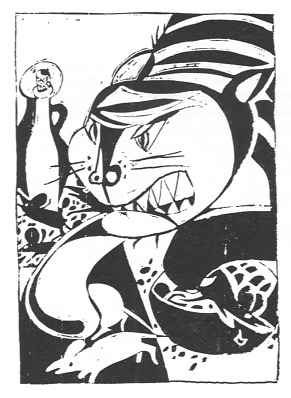Illustrations

A fable by the Persian writer 'Obayd-e Zakani (appr. 1300-1370), illustrated in ten first black and white and later 4- and 5-colored linoleum prints by Farangis.
The original black and white version of the illustrations for Zakani's story ‘About Cat and Mice’ has been exhibited 1985 at the School of Oriental and African Studies, University of London / England and 1986 at the Library of the University of Chicago in Illinois, USA.
Also in the mid-eighties, the four- and five-colored edition was released in cooperation with the German hand printer the Harrisfeldwegpresse. The decision to turn the graphics into a multicolored version was led by a fascination with working out variations, and also a result of a synthesis in creative exchange between the Edition Farangis and the Harrisfeldwegpresse.
By displaying the illustrations here as an e-reader we want to primarily emphasize the aspect of the story that makes up the intersecting part between arts and politics. The story ‘About Cat and Mice’ still has just as much political relevance as it had in the past. Packed into a seemingly harmless sounding fable, the story conveys a strong moral message: The uphill battle of the weak against the strong; it mirrors the emotional dilemma of the ‘eternal political looser’.

The initial black and white version of Farangis illustrations make the straightness and clearness of the applied technique in particular clear. Using the linoleum print as a method for creating an arts print has often been underestimated, perhaps since the material is a preferred medium for beginners. But it is exactly the ‘simple’ black and white linoleum block print, that can – depending on the cutting technique – create such a strong dynamical expression.
But also the colored print does not lose the specialness of a linoleum print. Transferring the strictness of the clear black and white cuts into colors worked equally well by using an intense color scheme. The usage of copper printing paper, which has an unglued and rough surface, made an almost impressionistic coloring possible in the handprints.
